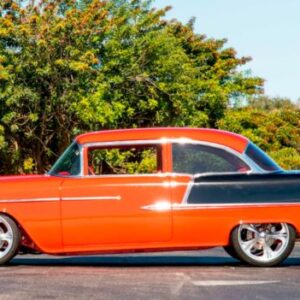In the world of classic American muscle cars, few models have stood the test of time quite like the 1963 Pontiac Tempest. This iconic vehicle has captured the hearts of car enthusiasts across generations, earning its place in automotive history as a symbol of power, performance, and sleek design.
-1686959106x1024.jpg)
This article will take a closer look at the 1963 Pontiac Tempest, exploring its unique features, the history behind its creation, and why it remains a popular choice among collectors and restorers today.
1. A Breakthrough in Design: The 1963 Pontiac Tempest
The 1963 Pontiac Tempest was a game-changer in the automotive industry, featuring innovative design elements that set it apart from its competitors. The Tempest was designed as part of Pontiac’s new “Y-body” compact car lineup, which included the Buick Special and Oldsmobile F-85. The Tempest’s distinctive features included its rear transaxle, which improved weight distribution and handling, and a selection of powerful engine options that set it apart from other compact cars of the era.
2. Design
The 1963 Pontiac Tempest was a mid-size car produced by Pontiac, a division of General Motors. It was available in various body styles, including a two-door coupe, a four-door sedan, a station wagon, and a convertible. The design of the 1963 Pontiac Tempest was influenced by the “Coke bottle” styling that was popular during that era. Here are some key design features of the 1963 Pontiac Tempest:
Exterior
Front End: The front end featured a prominent split grille design with horizontal chrome bars. The grille was flanked by quad headlights, giving the car a distinctive and aggressive appearance.
Body Lines: The body of the Tempest had smooth, flowing lines that emphasized its aerodynamic look. The car featured gently curved fenders and a sleek profile.
Roofline: The roofline of the Tempest varied depending on the body style. The coupe and convertible models had a more sloping and sporty roofline, while the sedan and wagon models had a more upright and practical design.
Tail End: At the rear, the Tempest had rounded taillights that were integrated into the rear fenders. The trunk lid had a clean and simple design, complementing the overall styling of the car.
Interior
Dashboard: The dashboard of the 1963 Tempest had a symmetrical layout with a combination of round and rectangular gauges. It featured a wide speedometer and various control knobs and switches for the car’s functions.
Seating: The Tempest had comfortable seating for up to six passengers, depending on the body style. The interior upholstery options included a range of colors and patterns to suit the owner’s preferences.
-1686959204x1024.jpg)
Trim and Accents: The interior featured chrome accents on the door handles, window cranks, and dashboard. The steering wheel and gear shifter also had chrome detailing.
3. Engine and Performance
The 1963 Pontiac Tempest offered a variety of engine options, each providing different levels of performance. Here are some of the available engines and their specifications:
194 cubic inch (3.2L) Inline-Six
This engine, known as the “Tempest LeMans,” was a significant innovation for its time. It was longitudinally mounted in the rear of the car, paired with a rear transaxle configuration. The engine produced approximately 140 horsepower and 200 lb-ft of torque. This setup helped improve weight distribution and traction, enhancing the car’s handling characteristics.
215 cubic inch (3.5L) Inline-Six
Another option was the larger inline-six engine, which produced around 155 horsepower and 215 lb-ft of torque. It featured a more traditional front-mounted engine design and was available with a three-speed manual or two-speed automatic transmission.
326 cubic inch (5.3L) V8
For those seeking more power, Pontiac offered a V8 engine option. The 326 cubic inch V8 produced approximately 260 horsepower and 352 lb-ft of torque. It provided increased acceleration and a more spirited driving experience. The V8 engine was available with a three-speed manual or a three-speed automatic transmission.
-1686959238.jpg)
Optional High-Performance Engines
Pontiac also offered high-performance engine options for the Tempest. These included the 326 cubic inch (5.3L) V8 engine with upgraded components, producing up to 285 horsepower and 376 lb-ft of torque. Additionally, there was a 389 cubic inch (6.4L) V8 engine available, offering even more power with outputs ranging from 267 to 348 horsepower, depending on the specific configuration.
4. Market Reception of the 1963 Pontiac Tempest: A Hit Among Car Buyers
The 1963 Pontiac Tempest was well-received in the market, attracting car buyers who were looking for a vehicle that combined the compact size and affordability of a smaller car with the power and performance of a muscle car. The Tempest’s unique design and engineering innovations further set it apart from its competitors and contributed to its popularity among consumers.
-1686959255x1024.jpg)
Sales Success: A Popular Choice in the 1960s
The Pontiac Tempest, introduced in 1961, quickly became a sales success for the brand. The 1963 model, in particular, benefited from the improvements and additional engine options introduced throughout the first generation of the Tempest (1961-1963). The availability of the 326 cubic inch V8 engine, which offered exceptional performance for a compact car, made the 1963 Pontiac Tempest especially attractive to buyers who wanted a powerful, yet affordable, vehicle.
-1686959269.jpg)
Pontiac’s reputation for performance and style helped boost sales of the Tempest, as the brand solidified its position as a major player in the muscle car market during the 1960s. The Tempest’s sales success contributed to Pontiac’s overall growth and paved the way for the introduction of other iconic models, such as the GTO and Firebird.
Positive Reviews: Praise from the Automotive Press
The 1963 Pontiac Tempest received positive reviews from automotive journalists and publications at the time. The car’s innovative design, including its rear transaxle and unique engine options, garnered praise for its innovation and performance capabilities. The Tempest was often compared favorably to its competitors in the compact and muscle car segments, with many reviewers highlighting its impressive power-to-weight ratio and handling characteristics.
-1686959297x1024.jpg)
A Lasting Impression: The 1963 Pontiac Tempest’s Legacy
The market reception of the 1963 Pontiac Tempest played a significant role in cementing its status as a classic American muscle car. Its sales success and positive reviews helped to establish Pontiac as a leader in performance vehicles, and the Tempest’s enduring popularity among car enthusiasts demonstrates its lasting impact on the automotive industry.
In summary, the 1963 Pontiac Tempest enjoyed a strong market reception, thanks to its combination of performance, innovation, and style. The vehicle’s sales success and positive reviews from the automotive press contributed to its lasting legacy as a classic American muscle car and an icon of 1960s automobile design.
5. Sales and production of 1963 Pontiac Tempest
Exact production and sales numbers for the 1963 Pontiac Tempest can be difficult to pinpoint due to limited available data and the fact that these numbers were often combined with those of other Pontiac models. However, it is clear that the Tempest enjoyed considerable success during its first generation (1961-1963), which contributed to Pontiac’s overall growth during the 1960s.
In 1963, Pontiac sold a total of 539,112 vehicles, making it the third-best-selling brand in the United States that year. While this figure includes sales of all Pontiac models, it is indicative of the strong demand for Pontiac vehicles during this time, which was driven in part by the popularity of the Tempest.
-1686959335x1024.jpg)
The Tempest was available in several body styles and trim levels, including the base Tempest, Tempest Custom, and the sportier Tempest LeMans. Each of these models contributed to the overall sales and production figures for the 1963 Pontiac Tempest.
While exact production numbers for the 1963 Pontiac Tempest are not readily available, it is evident that the model played a significant role in Pontiac’s success during the 1960s. The Tempest’s blend of performance, innovation, and style captured the attention of car buyers, helping to solidify Pontiac’s reputation as a major player in the American automotive market.
6. Cultural Values
The cultural values associated with the 1963 Pontiac Tempest can be understood by examining the prevailing attitudes and trends of the time. Here are some cultural values that were often associated with the Pontiac Tempest and similar vehicles of that era:
Freedom and Individualism
The 1960s marked a period of growing individualism and personal freedom, and car ownership was seen as a symbol of independence. The Pontiac Tempest represented the desire for personal mobility and the ability to explore the open road, reflecting the cultural values of freedom and individual expression.
-1686959350x1024.jpg)
Style and Status
Automobiles were also viewed as status symbols during the 1960s. The design and appearance of a car played a significant role in its cultural appeal. The Pontiac Tempest, with its sleek and stylish design, aimed to capture the attention of buyers looking to make a statement and showcase their taste and status.
Performance and Power
The 1960s witnessed a rise in interest in performance-oriented vehicles. Car enthusiasts and drivers sought cars with powerful engines and engaging driving experiences. The Pontiac Tempest, with its range of engine options, including the V8 engines, catered to those seeking performance and power, aligning with the cultural values of speed and excitement.
-1686959366x1024.jpg)
Innovation and Engineering
The Tempest’s unique rear-mounted transaxle configuration and the Tempest LeMans inline-six engine showcased a spirit of innovation and engineering prowess. During this era, technological advancements and groundbreaking designs were celebrated, and the Tempest’s engineering innovations were seen as a reflection of progress and forward-thinking.
Family and Practicality
While the Tempest offered performance and style, it was also available in practical body styles like sedans and wagons. These options appealed to families or individuals seeking a versatile and functional vehicle. The car’s ability to accommodate passengers and provide utility aligned with the cultural values of family and practicality.
-1686959386x1024.jpg)
These cultural values of freedom, individualism, style, performance, innovation, and practicality were often associated with the 1963 Pontiac Tempest and contributed to its popularity and cultural significance during that time.





